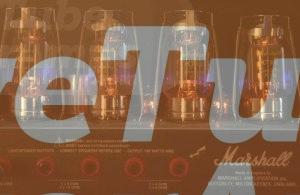What makes a valve fail in your amp
Let’s have a light look at valves.
Ever wondered why if you buy a nice new valve ( tube) amp that the amp has 2 years warranty and if you check the small print on the warranty carefully, you will see the valve warranty is a lot shorter – perhaps only 90 days!
Valves are very old electronics technology. They were invented in 1910 and have been around ever since. They are glass tubes with a vaccum inside. The simplest is a triode ( there are two triodes in an ECC83/12AX7) . A triode is an anode, a cathode and a grid. ( there is a heater to get the device up to temperature). It works just like a water tap. The anode is the water pipe going into the tap. The knob to turn of and on the water or control the flow and the cathode is the water coming out. Small adjustments on the knob can vary the flow greatly. The grid does exactly the same . Small changes of grid voltage cause big changes in the current flowing from anode to cathode =amplification. I know this is maybe over-simplified but hope it gives you the principle Pentodes have more grids and the complexities of why these are needed are not included as it is a bit of a yawn to go through all of that stuff.
So what goes wrong with them and why do they “wear out” ?
Gas Leak and loosing vacuum
If there is a leak in the glass then the vacuum goes. This can be a slow leak. Valves have a material inside so you see a shiny metallic surface ( it is called the ” getter” . It is there to react with any impurities and absorb any material in the vacuum. If there is a leak the glass goes dull. It is a dead valve and when gas gets into the valve this is the valve going “soft”
Microphonics
Valves are mechanical and depend on the metal structures inside being rigid. Guitar amps get moved around in the back of vans. Whenn the amp is in use especially in combos, there are a lot of vibration from the speaker(s). The result is that the mechanics inside the valve work loose. The valve then becomes ” Microphonic”. If you tap the offending valve, you can actually hear the tapping on the sound just as if you are tapping a microphone. Its time to replace the valve. This happens on your EEC81/ECC82/ECC83 double triodes.
Worn Valves
Earlier I mentioned the current flows from the anode to the cathode. The heater’s job is to heat up the cathode and this makes it emit electrons so that the current flows. The cathode is coated in a special material to make it emit electrons. Over time, the cathode material emits less electrons. Its gain drops off and it is best to replace the valve and keep it as spare. Next time you read stuff about ” dark valves” it is just worn out valves and not a lot of life left in them. Our digital tester can test for this. A good marketing trick is to test my old valves, find the worn ones and put them on Ebay calling them dark valves and carefully not mention the warranty, plus ask a big price. I am sure no-one would do that.
Blown like Light Bulb
The heater is just like a light bulb as it has a filament that glows. So an obvious test if your amp is dead is to check that all the valves have a nice cark orange glow. Just like light bulbs the heaters fail. If this happens, replace the tube. If the replacement does not work, and the other valves are glowing , then either the heater circuit wiring is faulty or the valve base socket has a problem. Try moving the valve around in the base socket to see if it will at least temporarily work. I have had to replace faulty valve bases in vintage amps. The metal in the sockets gets fatigued and does not spring closed around the pins
This is obviously not every fault listed but I hope it gives you some useful info .
Red-Plating
This is when the bias is lost to valve. The valve ends up drawing as much current as is available. The metal plates ( don’t confuse this with the heater) glow dull or even bright red. This is due to all the power running through them. Hoipefully the HT fuse will blow. Often the valve is destroyed as the plates inside are distorted with the heat. The bias volts can vanish due to a broken track or wire, the diode in the bias circuit facing, or the smoothing capacitor going leaky and pulling the volts down.
This is obviously not every fault listed but I hope it gives you some useful info

